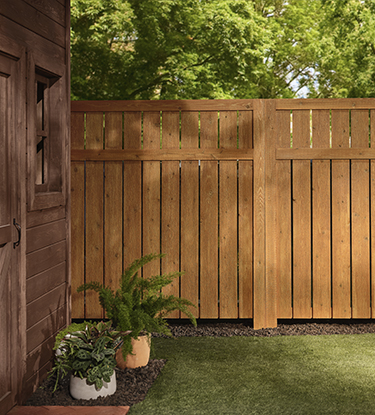How to Choose the Right Fencing Discoloration for Your Residential Or Commercial Property
When it comes to boosting the look and sturdiness of your residential property's fence, picking the ideal stain is a crucial choice that requires cautious factor to consider. With a myriad of alternatives offered in the marketplace, each accommodating different wood types, shades, and transparency levels, the process can quickly end up being frustrating. However, making an enlightened choice can dramatically affect the overall looks and durability of your fence. So, how can you make sure that you choose the perfect fence stain that lines up with your building's style and maintenance demands? Allow's explore some key elements to assist you in this decision-making procedure.
Understanding Timber Types
To select the appropriate fence stain, it is important to have a detailed understanding of the different types of wood typically utilized for fence. When choosing a fence tarnish, it is vital to consider the kind of timber being utilized to make sure compatibility and optimum security. Understanding the features of different wood types will certainly aid you make a notified decision when it comes to choosing the appropriate fencing tarnish for your residential or commercial property.
Picking the Right Shade
Choosing an ideal shade for your fencing tarnish is a crucial choice that considerably influences the general aesthetic appeal of your building. The shade you choose must match the design of your home, blend harmoniously with the surroundings, and reflect your personal taste. When picking a color, consider the existing shade combination of your home. For a natural look, earthy tones like browns, environment-friendlies, or grays function well. These colors can aid the fence mix into the landscape and produce a natural appearance. If you like an even more modern-day or strong look, take into consideration deciding for darker tones like black or deep charcoal for a striking contrast. Lighter shades such as whites or light grays can make a fencing show up larger and include a touch of elegance to your residential property. Inevitably, the ideal color selection will certainly improve the elegance of your fence and elevate the general aesthetic allure of your home.

Taking Into Consideration Openness Levels
When selecting the ideal shade for your fence stain, an additional vital aspect to think about is the degree of transparency that will certainly ideal fit your building's aesthetic and upkeep demands. Transparency levels in fencing spots normally drop into 3 groups: clear, semi-transparent, and solid. Take into consideration the degree of direct exposure your fencing deals with, the desired upkeep regularity, and the aesthetic you want to attain when selecting the ideal transparency level for your fencing discolor.
Evaluating Upkeep Requirements
Thinking about the long life and upkeep of your fence, reviewing the upkeep demands is important in figuring out the most suitable fence discolor for your building. The level of maintenance needed for your fencing web link can differ depending upon aspects such as the kind of timber, climate condition in your location, and your personal choices.
When reviewing upkeep requirements, it is vital to think about the longevity of the fence tarnish. Some stains call for more frequent reapplication than others, so selecting a discolor with a much longer life expectancy can help in reducing the overall upkeep requirements of your fence (Fence Staining Service). Furthermore, variables such as resistance to UV rays, water, and mildew can affect just how frequently you need to re-stain your fencing

Testing Examples Before Application
Before using any kind of fence discolor, it is a good idea to perform example examinations to ensure compatibility with the timber and desired visual result (Fence Staining). Testing examples permits you to analyze just how the stain will certainly communicate with the certain kind of timber used in your fence, as various timbers can absorb stains in a different way. To begin, select a little low-profile area of the fence to use the stain examples. It is recommended to check multiple discolor options on this section to compare shades and coatings. Consider how the discolor looks when dry, as it may appear different from its damp application. Additionally, observe how the tarnish complements the existing components in your outdoor space, such as landscaping or the color of your home. Make note of how the discolor holds up to weather problems like sunlight and dampness. By checking samples prior to full application, you can make an educated choice that boosts the general look of your property while securing the wood effectively.
Verdict
To conclude, selecting the proper fencing discolor for your property includes recognizing the timber kind, selecting the appropriate color, thinking about transparency degrees, examining upkeep demands, and testing examples prior to application (Fence Staining). By taking these variables into factor to consider, you can make certain that your fence discolor enhances your property while providing the required defense and resilience. Make an educated decision to enhance the appearance and durability of your fence